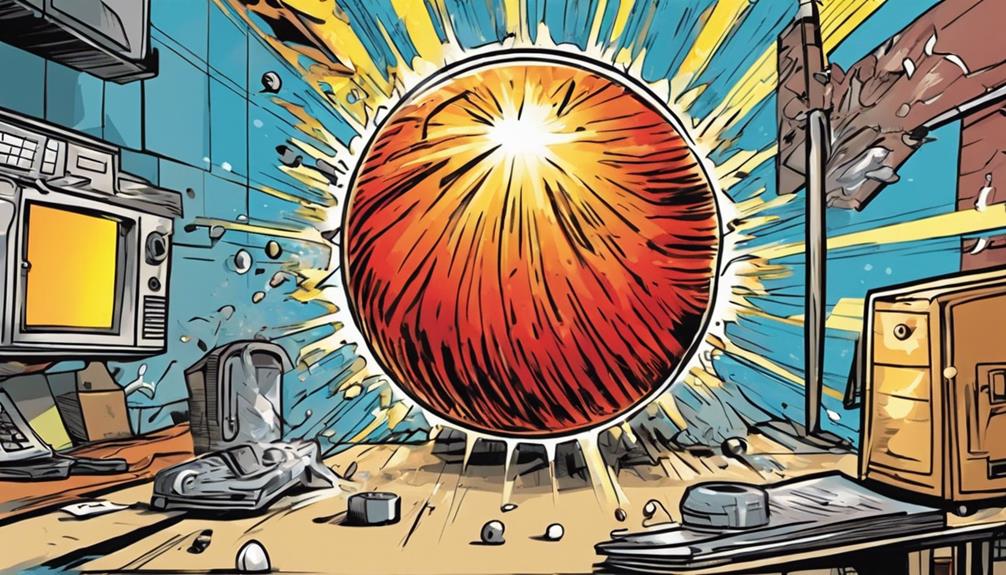To turn kinetic energy into thermal energy, let motion, friction, and collisions work their magic. When things move, rub together, or crash, energy changes form and heats things up. Feel the heat when rubbing hands vigorously? That's kinetic energy converting to warmth. See energy in action with experiments like Colliding Steel Spheres or Silly Putty demos. And remember, these examples are just the start of explaining how kinetic energy transforms. More details await on how these processes make the energy shift from motion to thermal – keep exploring to uncover further insights.
Key Takeaways
- Friction between surfaces transforms kinetic energy into heat.
- Collisions convert kinetic energy into thermal energy.
- Kinetic energy is converted to thermal energy through motion.
- Energy conservation principles demonstrate kinetic to thermal energy conversion.
- Moving objects encountering friction generate thermal energy.
Energy Conversion Processes
When converting kinetic energy to thermal energy, energy conversion processes involve transforming the energy of motion into internal energy within a system. This conversion is particularly evident when a moving object encounters friction or engages in a collision, leading to the generation of thermal energy.
Friction between surfaces is a common way in which kinetic energy is converted into thermal energy. As the surfaces rub against each other, the kinetic energy of the moving object is transformed into heat, increasing the temperature of the system.
Similarly, during collisions between objects, the kinetic energy of the moving objects is converted into thermal energy upon impact, heating up the objects involved. This conversion highlights the interconnectedness of energy forms and the principle of energy conservation, showcasing how kinetic energy can be effectively transformed into thermal energy through various processes involving motion, friction, and collisions.
Visual Demonstrations and Experiments

Explore enthralling visual demonstrations and experiments that vividly illustrate the conversion of kinetic energy into heat.
The Colliding Steel Spheres experiment showcases how kinetic energy is converted into thermal energy through the collision of steel spheres, resulting in the burning of a piece of paper.
Similarly, the Fire Syringe demonstration involves rapid air compression igniting a cotton ball, visually displaying the transformation of kinetic energy into heat energy.
Additionally, the Silly Putty, hammer, and temperature probe demo provide a clear temperature rise post-impact, illustrating the conversion process effectively.
These experiments, like the Fire Syringe and Silly Putty demos, offer captivating ways to connect kinetic energy to thermal energy conversion for educational purposes.
Cautionary Measures for Fire Syringe

Proper maintenance and handling of the fire syringe are vital to guarantee safe and successful demonstrations. When using the fire syringe, make sure that the o-rings are well-lubricated and provide a good seal for effective compression. This compression is essential for converting kinetic energy into thermal energy, igniting the cotton fibers within the syringe.
Position the cotton fibers appropriately to enhance heating efficiency, aiming for a small cotton ball with a lot of surface area to facilitate the conversion of kinetic energy. Attention to detail is crucial, as even minor errors in handling or setup can impact the performance of the fire syringe.
Prioritize caution when conducting demonstrations, and consider using a temperature probe to monitor heat levels and ensure safe operation. By following these precautions, you can maximize the effectiveness of the fire syringe while maintaining a safe environment for experimentation.
Educational Impact and Applications

Engage students in dynamic learning experiences by showcasing kinetic energy transformations through mesmerizing demonstrations. Witness kinetic energy being converted into thermal energy with enthralling experiments like the Colliding Steel Spheres or the Silly Putty and Hammer demo.
These demonstrations, where potential energy is transformed into a rise in temperature, are essential for understanding the principles of energy conversion. Associate Professor of Physics, use a small Fire Syringe demo to illustrate how kinetic energy can be converted into heat energy, igniting a cotton ball through air compression.
Relationship Between Thermal and Kinetic Energy

Understanding the inherent connection between thermal and kinetic energy is vital in comprehending the dynamics of energy transformations within a system.
When kinetic energy is transferred into thermal energy, it effectively results in an increase in temperature within the system. This process can be visualized through the example of rubbing your hands together vigorously. The kinetic energy produced by the rubbing motion is converted into thermal energy, causing your hands to feel warmer.
A couple of things happen in this scenario: the friction generated between your hands allows for the conversion of kinetic energy into another form of energy, which manifests as heat. The particles in your hands receive this kinetic energy and start to move more rapidly, increasing the overall thermal energy of your hands.
In a similar way, when a ball bounces back after hitting the ground, the kinetic energy of the ball is converted into thermal energy, albeit on a smaller scale.
Frequently Asked Questions
What Can Cause Kinetic Energy to Change Into Thermal Energy?
To change kinetic energy into thermal energy, various processes occur. Collisions convert macroscopic motion to microscopic particle motion. Friction between surfaces transforms mechanical energy into heat. Impact, deformation, and compression of gases also lead to this transformation.
Which of These Is a Conversion of Kinetic Energy to Thermal Energy?
When you witness a water balloon hitting the ground or steel spheres colliding, you see kinetic energy transform into thermal energy. The impact generates heat, demonstrating a direct conversion process from motion to heat energy.
Can Kinetic Energy Make Heat?
Yes, kinetic energy can make heat. When objects in motion stop due to friction, impact, or compression, their kinetic energy transforms into thermal energy, causing a temperature increase. This process demonstrates the conversion between different forms of energy.
How Is Kinetic Energy Transferred to a Surface as Heat?
When an object in motion collides with a surface, its kinetic energy transforms into thermal energy due to friction. This process generates heat, causing a temperature increase in the surface. Understanding this conversion is essential for energy conservation principles.
What is the relationship between kinetic energy and thermal energy in the context of bond length and lattice energy calculations?
The relationship between kinetic energy and thermal energy is crucial when trying to calculate equilibrium bond length in the context of lattice energy calculations. The kinetic energy of particles increases as temperature rises, affecting the vibrations of atoms and ultimately influencing bond length and lattice energy.
Conclusion
So, next time you see a fire syringe demonstration, remember how kinetic energy transformed into thermal energy right before your eyes.
It's like magic – the rapid compression of air creates heat, showcasing the powerful relationship between motion and temperature.
Keep exploring the fascinating world of energy conversion, and who knows what other incredible transformations you might witness!










